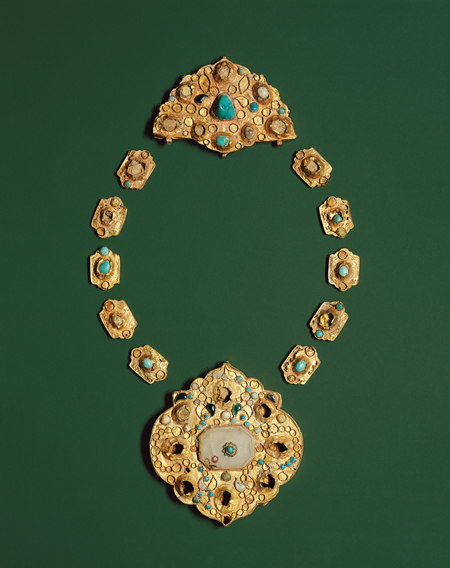The Field Museum Information: Press Room
Whenever I see an exhibit of ancient jewelry, I am always surprised by how current it looks. I have to remind myself that jewelry-making is an ancient enterprise, using the same materials and essentially the same tools that have been used for centuries.
Here’s a picture of the remnants of a gold, turquoise, chalcedony, and glass necklace from 14th century Iran:

A necklace from Iran, circa 14th century
I had a jewelry show of my own work earlier today, in which I sold gold, turquoise, chalcedony, and glass bracelets, earrings, and necklaces.
The only difference between what I sold today and the pieces from antiquity is that my materials were beads, and they were strung, not set.
Despite those minor differences, some things just do not change. When I set a stone in metal, it is very likely to be bezel set – a thin strip of metal in the shape of the stone is soldered to the main piece of the work. The stone – either faceted or cabochon – is placed in the bezel which is then burnished to mold the bezel to the stone and hold it in place. Take a closer look at the necklace above. The top two pieces, just below what must have been the clasp, are empty bezels. They have lost their stones. Take a close look at the clasp and the pendant. You can see circles that look almost like bubbles in this photograph. Each of those circles is an empty bezel that has lost its stone.
Not all of the bezels are circles, either. Other empty bezel shapes like oval and paisley are also visible.
This is an ancient technique. Undoubtedly the solder we use today comes in a different form than they had – for example, mine is very thin sheet and comes in soft, medium, or hard – but the way it’s used is exactly the same.
In February, an entire collection of jewelry antiquities from Mesopotamia, Egypt, the Levant, Persia, and the Islamic Middle East will go on display at the Field Museum in Chicago. They will be accompanied by maps and other illustrations that will place the jewelry in the context of its culture and time.